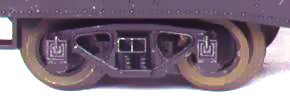
All About Aurora Postage Stamp Trains
Genuine Rolling Stock
Buyer Beware
Freight cars are among the most frequently misrepresented Postage Stamp items sold online. People often just sell whatever they found/bought/received in the box, regardless of whether or not the car was ever offered by Aurora.
 The problem is three-fold. First, many box inserts
only identify the generic car type (right), with no road name or road code, so people assume whatever is already in the box is what
originally came in the box—if they even bother to read the insert, that is. Second,
Roco
supplied cars to multiple importers, and many of those cars were similar, if not identical, to the ones sold by Aurora.
And third, Trix released more cars than Aurora imported;
consequently you'll see such impossibilities as wood-sided reefers and triple-dome tankers in Postage Stamp boxes almost every single day, all
assumed to be legitimate simply because the cars are branded for Trix and match the generic car types on the inserts.
The problem is three-fold. First, many box inserts
only identify the generic car type (right), with no road name or road code, so people assume whatever is already in the box is what
originally came in the box—if they even bother to read the insert, that is. Second,
Roco
supplied cars to multiple importers, and many of those cars were similar, if not identical, to the ones sold by Aurora.
And third, Trix released more cars than Aurora imported;
consequently you'll see such impossibilities as wood-sided reefers and triple-dome tankers in Postage Stamp boxes almost every single day, all
assumed to be legitimate simply because the cars are branded for Trix and match the generic car types on the inserts.
 The cardboard boxes create an even
bigger problem: cars are identified only by catalog number and road code. Very few people understand what the numbers mean, and even fewer may
be inclined to look them up—assuming they knew where to look. Consequently, a box can contain whatever random thing the last person stuffed into
it. You'd be surprised (or
possibly not) at the totally oddball cars I've found in many of them; example: a European passenger car in an American freight car box. Pop quiz: What
comes in the box shown above right? (Answer at the bottom of the page.)
The cardboard boxes create an even
bigger problem: cars are identified only by catalog number and road code. Very few people understand what the numbers mean, and even fewer may
be inclined to look them up—assuming they knew where to look. Consequently, a box can contain whatever random thing the last person stuffed into
it. You'd be surprised (or
possibly not) at the totally oddball cars I've found in many of them; example: a European passenger car in an American freight car box. Pop quiz: What
comes in the box shown above right? (Answer at the bottom of the page.)
Not to mention that these cars have been re-released countless times over the years, and unless you pay strict attention to specific little details such as the color of the wheels or the shape of the bolster pins, it may be a later-vintage car in that Postage Stamp box you just bought. Then there's the fact that nearly all of the cars for sale today are used, presenting the chance they've been repaired or altered in some way—say, upgraded with new(er) trucks and couplers. And some especially dirty cars have been described as "weathered!"
Due to the long production history and broad distribution of these cars, there will be those that match all of the criteria, yet aren't truly "genuine." There's no practical way to determine this, nor is it really worth the effort. In the grand scheme of things, it doesn't matter, because these days the cars are a dime a dozen. Indeed, the boxes may be of more value to some collectors (like myself) than their contents.
What To Look For
At the very least, genuine Postage Stamp freight cars will:
- be branded "TRIX AUSTRIA"
- be of a car type and road name listed on the index
- have original trucks, couplers, and bolster pins
- have all original add-on detail items, such as roof walks and brake wheels, which will all be black plastic
Trucks provide some of the best indicators of a car's authenticity, and there are two vintages. First-generation cars will have:
- brass wheels, which appear as a dull tarnished brass color, with flat faces
- small black plastic insulators on both sides that protrude from the wheel backs*
- thin stainless steel axles
- truck frame with angled sides and rounded corners around the bolster pin
- flat-headed bolster pin
- rectangular blackened steel coupler retaining clip
- Rapido-style coupler
*Note that on a very few first-generation cars, the wheel insulators may be translucent plastic instead of black.

The wheels on second generation trucks have larger-diameter black plastic insulators that are flush with the wheel backs (2). Also, the car below is used; compare the discoloration of the parts with those of the 100% mint car above.

The generation of the wheels is evident from the side; first gen is on the left.


Effects of Age
As these cars age, the plastic shrinks slightly. Consequently, wheels may come loose from their insulators; the top right wheel in the first photo above has done this. Bolster pins will also tend to come loose, and trucks will drop off—this can often be seen in train sets that are still factory-sealed. Wheels will get darker and duller or sometimes aqua-green, and the coupler retaining clip may become slightly rusty. Black plastic will loose its faint sheen and turn a dull, mottled medium to dark grey.
These products weren't meant to be heirlooms; they're merely mass-produced toys.
Pop quiz answer: Carnation Refrigerator Car